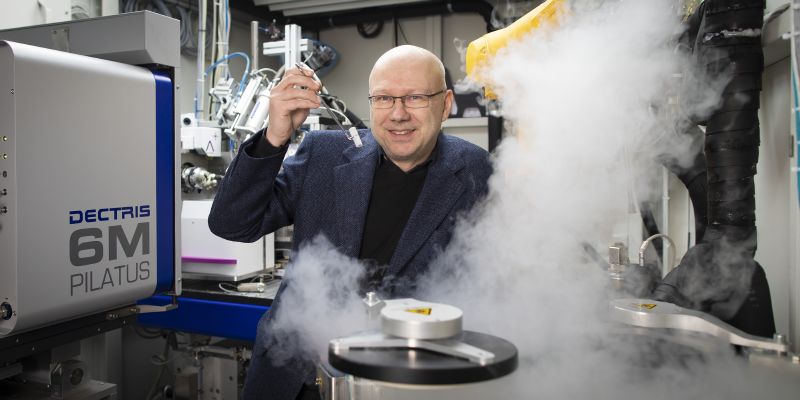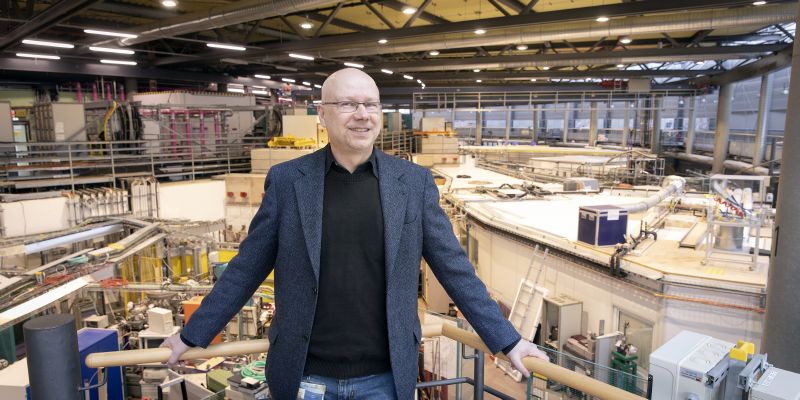Probing the keys to life with X-rays
Portrait of Dr Manfred Weiss
Chemist Manfred Weiss heads the operations of the MX beamlines at the Adlershof campus of Helmholtz Zentrum Berlin – used by researchers and pharmaceutical companies to study the crystallised structure of molecules, usually in search of new drugs.
Editor's note: this article appeared in the March 2019 edition of the HZB magazine "lichtblick", though some numbers in the article have been updated. During the pandemic, most measurements are made remotely, which means users connect online from home.
He still remembers the telephone call at 4 a.m.: Manfred Weiss was on-call, while on the other end of the phone line were scientists who were just finishing their experiments using one of his beamlines.
“We're done, everything went well - thank you very much”,
they told the chemist, still half asleep. It was a few years ago, and Weiss smiles when he thinks about it: “That was the most bizarre call I've had so far.”
This memory says a lot about the work of Weiss, who is responsible for the experiments in the field of macromolecular crystallography at the BESSY II electron storage ring. His team is on duty around the clock to look after scientists from around the world who make their measurements here - and it shows how satisfied these users are that they quite naturally just want to say thank you, even in the middle of the night.
Weiss' upstairs office is just a few steps from the three MX beamlines that the team looks after, right beyond the cafeteria at the Helmholtz Zentrum Berlin (HZB). Orderly stacks of user files on his desk are the most visible sign of the workload Weiss and his colleagues deal with.
Research groups and companies come from around the world to study their samples using the X-rays produced at BESSY II.
The structure of crystallised proteins is revealed here using this special non-destructive irradiation, which is extremely important for pharmaceutical research, for example. Once scientists have discovered which molecules in the human body "go crazy" (as Weiss calls it) due to a certain disease, they search for substances that can dock precisely onto the affected protein molecule and thus function as active pharmaceutical agents. In order to find these suitable substances, the researchers have to completely understand their structure together with that of the target protein – this is exactly what macromolecular crystallography can help do.

There is a lot going on at the beamline! Manfred with with a sample ready to be immersed in liquid nitrogen.
Picture: Michael Setzpfandt
When Weiss talks about his work, you can hear a slight friendly southern German accent. He grew up in Baden-Württemberg, the first in his family to go to university – “and I still have that linguistic colouring with me, I can't get rid of it”, says the 55-year-old. Weiss remained true to his home province during his university studies by enrolling at the University of Freiburg and quickly took a liking to structural biology, which was only just beginning at the time.
“I came into this field of research at exactly the right time”,
says Weiss in retrospect. He spent a year as an exchange student in the USA before graduating, and after his doctorate he went to Los Angeles for a postdoctoral position. “That was more curiosity than career planning”, he says modestly and laughs. He was intrigued by the range of activities in the USA, which were considerable at the time. Back then in the mid-1990s, macromolecular crystallography was in its most expansive phase. After German researchers Johann Deisenhofer, Robert Huber, and Hartmut Michel won the Nobel Prize in 1988, the importance of the field became widely recognised. The latter Nobel laureates were the first to describe the structure of a membrane protein – the photoreaction centre – using the same pioneering techniques that Weiss used shortly afterwards in his doctoral thesis describing the structure of a pore-forming membrane protein.
While he was working in the USA, research groups dealing with macromolecular crystallography were springing up all over Germany. One of them was based in Jena at the then Institute for Molecular Biotechnology and Weiss returned to Germany in 1996 for a research position there. Five years later, he changed roles:
“I basically switched from being a user to an operator of the beamline”,
he says with a smile. He still studied his own samples, but his main job was to support colleagues at the beamlines operated by the European Molecular Biology Laboratory (EMBL) at the German Electron Synchrotron (DESY) in Hamburg. Weiss continued with this task when he took up his post at HZB in 2009.
Suddenly there is a knock at the door and a doctoral student pokes his head in. "Manfred, I haven't got a permanent dosimeter yet and I need to go over to the experiment hall”, he says. Such requests are also part of his job, says Weiss with a laugh. His team consists of twelve employees, so there is always something to be sorted out here and there. The team is well-coordinated, and together they manage an enormous workload: of all the biological structures studied and described in Germany, two-thirds can be traced back to the three MX beamlines at HZB Adlershof. “The technical progress has been crazy”, says Weiss shaking his head:
"When I was working on my doctoral thesis, it took a whole night to measure one crystal. Today, we do it in ten, at most 15 minutes.”
A higher degree of automation, better detectors, and last but not least the many years of experience of all those involved are the reasons behind this progress – and also behind the operational dependability of Bessy II, of course. “If you are allocated 24 hours of beam time, you get 24 hours”, is how Weiss puts it succinctly. It is extremely rare that measurement runs have to be interrupted because of technical problems. Of course, word of this reliability gets around among the users, and the experimental stations are heavily oversubscribed.
Almost 3,700 protein structures have been studied and described using the MX beamlines at BESSY II so far, making them by far the most productive in Germany.
Around 120 research groups come regularly, 40 per cent of them from Germany, the rest from many countries in Central and Eastern Europe, Scandinavia, and even Israel. Companies also come regularly to investigate possible new active substances. “I don't know what they are doing exactly – they often keep the information secret so that their competition doesn't overhear”, says Weiss. While these measurements are being run, he is already thinking about the next runs and sometimes about the molecules being investigated. Who knows? Perhaps the foundations for a pioneering cancer drug have already been laid here – perhaps even sometime around 4 a.m. when Manfred Weiss has his mobile phone next to his pillow and is on call in case something is not working.
Kilian Kirchgessner (03.2019)

